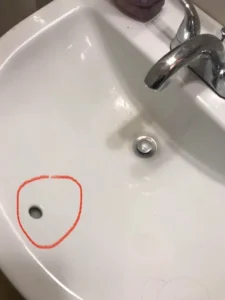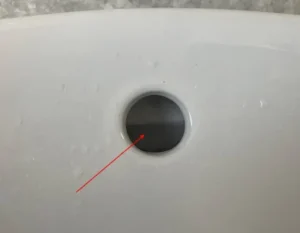In the majority of bathroom sinks, there is a small opening that is commonly overlooked. This opening is located next to the spigot, approximately one-third of the way up the basin. There are a great number of people who are curious about the purpose of this seemingly insignificant design component. Permit me to go deeper into its function and the most efficient way to maintain it.
Purpose of the Overflow Hole in Nature
This little opening is an essential component in the overall design of your sink’s internal structure. Overflow holes are thoughtful features that are designed to prevent liquid from spilling over the lip of the sink. These holes are connected to the plumbing that is located below the sink.

Operation: Preventing Overflow: When the sink is being used on a regular basis, the water level inside the sink can increase if the faucet is left on by accident or if the user becomes distracted (for example, by a phone call). Once it reaches the place where the overflow hole is located, the water is redirected via this opening into the plumbing that is located beneath it. This prevents any flooding that may occur and protects the floor of your bathroom from any damage that may be caused by water.
Several Potential Obstacles Presented by the Overflow Hole
The presence of this overflow feature is evidence of a well-thought-out design that takes into account the typical circumstances in which users may accidentally overfill the sink.

Several Potential Obstacles Presented by the Overflow Hole
It is possible that the overflow hole will present various challenges, despite the fact that it is advantageous:
Because of its location, the overflow hole has the potential to retain water, soap residue, and other particles. There is also the possibility that mold and bacteria will grow in this area. The presence of bacteria and mold in the hole can lead to the development of unpleasant odors, which can be caused by the proliferation of these organisms.
When it comes to odor control, if you notice an unpleasant stench coming from this small orifice, it is most likely the result of the accumulation of filth and bacteria. We are fortunate to have access to a straightforward cleaning option.
Preparing the Overflow Hole: Cleaning
The following procedures should be followed in order to clean the overflow hole in order to keep the sink and bathroom smelling clean:

In order to make a cleaning solution, combine vinegar and baking soda in proportions that are equal to one another. As a result of this amalgamation, a chemical reaction is triggered, which allows for the dislodging and cleaning of filth and sediments that are present in the pipelines.
Place the Mixture in Use: The mixture should be poured into the overflow hole. For around five to ten minutes, you should let it to sit and react.
Rinse with Warm Water: Once the reaction has taken place, it is necessary to rinse the sink with warm water in order to remove any residues that may still be present and to guarantee that the pipelines are empty.
Maintaining a sanitary environment in your bathroom and preventing the accumulation of offensive odors can be accomplished by cleaning the overflow hole on a regular basis.
The small opening that is located next to the spout of your bathroom sink is not merely an aesthetic feature; rather, it is a practical feature that is intended to prevent overflows and potential water damage. It is possible that it may occasionally store bacteria and smells; but, with regular maintenance with common household items, it can be kept in excellent condition and your bathroom will continue to smell pleasant. By gaining an understanding of and taking care of this feature, you can ensure that your sink will continue to function properly and be enjoyable to use.
